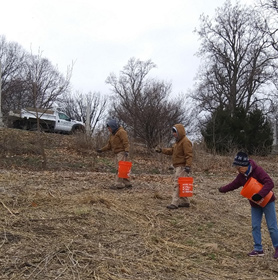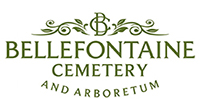Bellefontaine Cemetery and Arboretum Sustainability Statement
As both a historic institution and an active Cemetery, we understand the value of preserving the past and conserving it for future generations. As our motto (“Yesterday. Today. Forever.”) suggests, “Forever” extends beyond our gates into our local and global communities. As such, we proactively embrace a long-term vision of environmental stewardship driven by our ethical standards. We hope to minimize our negative footprint while maximizing our positive impact on our neighborhood and city.
In 2018, Bellefontaine Cemetery and Arboretum (BCA) joined the St. Louis Green Business Challenge (STLBC)—a local organization run through the Missouri Botanical Garden that assists local businesses, non-profit organizations, and municipalities to move towards more environmentally friendly operations. We started at the Apprentice Level during our first year and have since graduated to the Leadership Level and now are proud to have reached the Innovator Level. Through our partnership with STLGBC, we have been able to audit and overhaul many outdated systems. At BCA, we see our commitment to sustainability through three primary lenses: 1) Landscape Management and Biodiversity, 2) Energy Reduction and Resource Conservation, and 3) End-of-Life Services.
Landscape Management and Biodiversity:
Bellefontaine Cemetery and Arboretum comprises 314 acres of rolling hills, towering trees, enchanting gardens, and thousands of monuments. As Missouri’s first Level III Arboretum (and one of only 50+ in the world!), our mission is to support and enhance the Cemetery as a place of perpetual commemoration. We are implementing sustainable landscape management efforts to reduce irrigation usage, switch to eco-friendly fuel, decrease overall fuel consumption, and increase biodiversity.

In the effort to reduce water usage and mitigate stormwater runoff, we have:
- Minimized gardens that require irrigation.
- Transitioned to using majority native plant species that require less water to maintain and uptake water more efficiently in heavy rainfall.
- Redirected water from the sewer system by working with the St. Louis Metropolitan Sewer District (MSD) to install native plant bioswales that absorb excess rainwater.
To reduce the negative impact of mowing, we have:
- Switched from using gasoline fuel to more efficient propane fuel.
- Changed our mowing height to 3.5” to save vertical space for wildflower blooms, thus diversifying our lawn and providing more food sources for pollinators.
- Began mulching grass clippings and leaves directly on the ground to provide necessary organic matter for soil health and reduce other equipment and fuel usage.
- Transitioned conventional mown turf surfaces to native plant communities. These require less irrigation, chemicals, and mowing emissions and increase water infiltration and reduce surface water runoff. Additionally, they provide a habitat for pollinators, birds, and animals residing on the property.
To decrease significant delivery travel, we have:
- Started saving our green waste (stumps, wood chips, and weeds) to convert into mulch that we use on-site, eliminating the need for regular semi-truck deliveries of mulch and large waste bin removal. This practice alone diverts one metric ton of CO2 out of the atmosphere every year.
To encourage biodiversity and provide wildlife habitat, we have:
- Made a consistent effort to plant native trees, shrubs, and perennials to provide food and shelter for our native fauna.
- Built and maintained a clean stream and planted lakeshore beds to provide sanctuary for aquatic wildlife, native and migratory birds.
- Intentionally left standing dead trees and felled trees in designated areas for woodland species habitat.
- Eliminated using herbicides in our mown areas to cultivate the most biodiverse lawn possible.
Energy Reduction and Resource Conservation:
In addition to the changes we have made to our outdoor space, we’ve made that same commitment to making our building spaces as efficient and clean as possible. Some ways we have worked to reduce our energy consumption and conserve valuable resources include:
- Transitioning our offices and chapel to LED lighting, using the Ameren Small Business Incentive Program. This change alone helps us save over 50,000kWh annually.
- Installing programmable thermostats in all of our climate-controlled areas.
- Educating our staff on proper recycling practices.
- Hiring Recycling on the Go for larger events, for properly sorted compost and recycling.
- Prioritizing the purchase of electric and hybrid vehicles to set a precedent for future purchasing.

